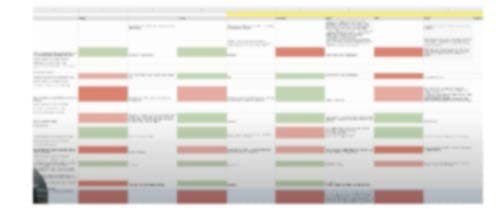3 Notetaking Strategies to boost your UXR effeciency
Notetaking is a passion of mine.
In the Ask Like a Pro Orchestrate workshop, we take a deep dive into different notetaking approaches that allow us to geek out on how to conduct more accurate, efficient, and powerful research for our sponsored project’s stakeholders and beyond.
Orchestrating research is such an exciting and eye-opening time in the UX research process as well as in our cohorts! And I love seeing the cohort light up when they acquire this new found knowledge!
A quick, important side-conversation on ethics: Interviewing with ethics and integrity requires recording with consent. You should always inform and receive confirmation from your participants any time you plan to use a conversation as part of your research.
Your role as UX researcher and/or note taker is to record what the participant(s) is expressing or doing. However, there are means to do this while also extracting the most important, relevant information with the least amount of bias possible. Notetaking methodologies like the ones I’m about to mention are best utilized during qualitative research.
Typical notetaking may look like this
Your typical method of notetaking, while familiar, is likely not the most efficient way to take notes.
Regardless of how comfortable you are with your typical notetaking practices, I invite you to explore other notetaking strategies and methods to maximize your efforts and expedite analysis and synthesis.
If you do take notes by hand, I recommend you do not take notes during an interview and wait until you can review the recording—especially if you are newer to the industry. Then, digitize them.
Empathy Mapping (aka TFSD)
TFSD stands for Think, Feel, Say, Do. With this method, you will be listening to how a participant responds to a question or topic.
TFSD is an empathy mapping approach, a visualization of trusted data used to express the understanding of a prospect, customer, or other personas.
This is one of my favorite notetaking frameworks because it switches up how we think notetaking should go. Physically on the page, your notes are split into four quadrants or categories. From there, you categorize reactions, thoughts, and ideas into four categories: Think, Feel, Say, Do.
Another reason I love this method is because you get to pay attention to more than what someone simply “says”. You also capture what they “do.” So, remember TFSD!
Transcriptions, “Opposites” and “Spectrum” Frameworks
The “Opposites” and “Spectrum” notetaking frameworks require clear and concise notes to start from. I recommend transcribing your recordings for this. If you’ve never worked with transcriptions before, this may be a learning opportunity! There are plenty of online services that transcribe recordings quickly and easily such as Temi.com and Rev.com. Reduct.Video is my favorite, though, because it does so much more than transcribe.
Then, choose a way to categorize the data into two viewpoints or along a “spectrum”. Opposing viewpoints are called “Opposites” because you’re looking for contrasts and plot your notes accordingly. "Spectrums" allow you to plot your data along a range or progression.
For instance, you might consider the following:
New Issues vs Recurring Issues is an example of simple Opposites.
Short-Term Goals vs Long-Term Opportunities is another example of Opposites. Add in “Mid-Term Considerations” and you have a Spectrum.
Positive Feedback vs Negative Feedback is a third example of Opposites. Add in “Neutral” and you have a Spectrum.
Spectrums can also be leveraged plot journeys and milestones. They don't have to relate to opposites. They are flexible but should be used consistently!
For additional inspiration, you can also look to Likert Scales. Our Likert Scales tool is one of my favorites ;) It may be beneficial to frame your notes in terms of frequency, availability, satisfaction, likelihood, etc.
TFSD, “Opposites” and "Spectrum" notetaking frameworks are just a few of the methods, strategies, and efficiencies that help UX researchers right size the information they collect as well as expedite analysis and synthesis.
Color coding
I also use color coding quite a bit and will write about that soon. Above are some examples.
If you want to take your notetaking skills a step further, I also suggest paying close attention to what you choose to take notes on and what you don’t. More notes, and more data, isn’t necessarily better. In fact, gathering extraneous data can cause a lot of rework because you have to extrapolate the information that does not tie directly to your study’s goals.
Shoring up your notetaking tactics will help you work smarter, not harder.
Speak up, get involved, and share the love!
Connect with Michele on LinkedIn for more UXR tips and UX discussions
Read about Curiosity Tank workshops. The next Ask Like A Pro series begins in late September!
Participate as an On-Demand, or as an Observer, for less!
Dive into a different UX Research term every week! Sign up for UX Lex weekly emails here.
Forward this email to someone who you think might enjoy it. Better yet, sign them up here. It will be the gift that keeps on giving.
And that’s a wrap!
We typically alternate between a theme and UX/UXR jobs, events, classes, articles, and other happenings every few weeks. Thank you for all of the feedback. Feedback is a gift and we continue to receive very actionable input on how to make Fuel Your Curiosity more meaningful to you.
What do you think? Lmk. We're constantly iterating and love to hear your input.
Stay curious,
- Michele and the Curiosity Tank team
PS: Our Ask Like A Pro cohort will begin in late February/Early March! Set up a personal call or Zoom with Michele to learn more!






